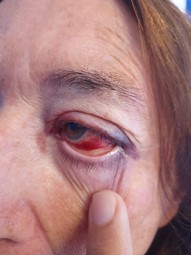Newsletter 2022
Newsletter March 2022: Clinical corner: A case of retrobulbar haematoma
Dr Cheah Kean Seng (MBBS, FCAI)
Department of Anaesthesia & Intensive Care
Tallaght University Hospital,
Dublin, Ireland.
dkscheah@gmail.com
Abstract
We encountered an unusual complication of general anaesthesia in which the patient developed an ocular complication from a non-ocular surgery. We noticed a sudden onset of left periorbital swelling after flexible ureteroscopy. Urgent CT orbit confirmed the diagnosis of left-sided retrobulbar haematoma. We closely observed for progression of orbital compartment syndrome. The patient remained asymptomatic and fortunately, the swelling subsided with conservative management. It brought to our attention and curiosity to investigate if similar complications had been reported in the literature in the past. It turned out to be more than our expectations.
Case description

Left subconjunctival haemorrhage post-op day 1
A 70-year-old female with a history of left breast cancer in remission for 9 years had undergone flexible ureteroscopy for investigation of haematuria. She was intubated with an endotracheal tube 7.5cm with a Mcgrath laryngoscope. The surgery was done in the lithotomy position and her head in the central position. The surgery went well and was completed within 1 hour. During emergence, on return of airway reflexes, she had a few mild coughs before being successfully extubated.
In the recovery bay, she developed unilateral left eye proptosis and periorbital swelling. She denied pain in the eye or a change in her vision. An urgent computed tomography (CT) of orbit reported a retrobulbar haematoma with the size of (2.4 x 1.2 x 1.4) cm. The haemorrhage is intraconal and focused on the superolateral quadrant. The resultant mass effect cause proptosis and inferomedial displacement of adjacent extraocular muscles and the orbital nerve. A review from the ophthalmology team did not show any change in vision or high intraocular pressure (IOP). There was no abnormality in the blood count or coagulation profile. Without the evidence of raised IOP or visual changes, we decided to manage conservatively and monitor for worsening progression. The following day swelling subsided but a small subconjunctival haemorrhage can be seen on the lateral part of the left eye (Figure 1). Clinically she remained asymptomatic with no change in her vision. A follow-up review from an Opthalmology colleague did not show worsening eye signs so we were happy to have her home in the evening.
Discussions
Ocular injury following non-ocular surgery is extremely rare with an incidence of 0.056% reported from a survey between 1988 to 1992¹. The most common cause was corneal abrasion whilst complete blindness was the least common cause. The specific cause can be identified only in 21% of the cases¹. Although it is rare it is associated with significant monetary settlement compared with claims against non-ocular injuries.
Orbital haemorrhage happens due to spontaneous rupture of vasculature around the eye. Some patients are particularly high risk such as the elderly, those with hypertension, diabetes, or coagulation disorders and patients on antiplatelet agents. Patients often could identify the trigger like bouts of coughing, straining or weight lifting before the incident. In another subgroup of patients (congenital or acquired vascular anomalies), the haemorrhage could occur through a trivial event and it is not uncommon if they could not recall the trigger. The fragile vasculature is at risk of rupture from venous congestion or a sudden increase in venous pressure from the valsalva manoeuvre. During valsalva manoeuvre, the venous pressure increases following rising in intra-abdominal pressure. Since the orbital veins do not contain a valve, this can easily lead to overpressure and rupture.
Five case reports of ocular haemorrhage after general anaesthesia have been reported in the literature so far (Table 1). One similar case report on retro-bulbar haemorrhage was dated back in 1987 after removal of chicken bone from the pharynx and likely attributed by thrombocytopenia.
Retrobulbar haemorrhage is usually caused by trauma to the face and orbit, or following surgery (maxillofacial or eye). Of late, ocular haemorrhage caused by retrobulbar block has been increasingly reported due to the increasing number of regional anaesthesia procedures being performed. In non-traumatic retrobulbar haemorrhage, a report suggests that 90% of the cases were related to ocular vascular malformations, 11% due to hypertension, coagulopathy or valsalva manoeuvre. No precipitating factor can be found in 5% of the cases⁷.
Table1: Summary of a case report on orbital haemorrhage published:
| Author | Patient background (Age/Gender/Co-morbids) | Complication | Procedure | Etiology/ Treatment |
| K.E.J Gunning et al²
Case report 1987 |
51 year old, female
Systemic lupus erythematous |
Retrobulbar haemorrhage | Removal of chicken bone from phaynx under general anaesthesia | Etiology: Thrombocytopenia
Treatment: Conservative management |
| K.K Anderson et al³
Case report 1994 |
72 year old, female
Arthritis and previous history of CVA |
Orbital haemorrhage | Hand arthroplasty | Etiology: No known etiology
Treatment: Conservative management |
| Kerry E Hunt. et al⁴
Case report 1998 |
74 year old, female
Healthy |
Subperiosteal haemorrhage in non-operated eye (right/non-operated eye) | Left eye phacoemulsification, lens implantation and trabeculectomy | Etiology: No known etiology
Treatment: Conservative management |
| Jon B Obray et al⁵
Case report 2002 |
67 year old, female
Oesophagal reflux, previous history of deep vein thrombosis |
Subconjunctival haemorrhage | Decompressive laminectomy | Etiology: Uncertain. Likely secondary to systemic hypertension or prone position
Treatment: Conservative management |
| H.N Saeed et al ⁶
Case report 2014 |
51 year old, female
Stage IV liver cirrhosis, oesophagal varices and thrombocytopenia |
Subperiosteal haematoma | OGD and banding of oesophagal varices | Etiology: Thrombocytopenia
Treatment: Orbitotomy and drainage of the haematoma |
The concern regarding ocular haemorrhage is the risk of vision loss in patient, which is very debilitating. The formation of haematoma within confined eye sockets could lead to an increase in intraorbital pressure (IOP) causing orbital compartment syndrome. Vision loss can happen through direct compression of the optic nerve, retinal artery occlusion, or compression of the vessel feeding the optic nerve. It has been suggested that the rise of pressure by just 3-6mmHg above normal is sufficient to compromise the blood flow to the optic nerve⁸. So there should not be a delay in referral for urgent ophthalmology evaluation. Both CT and MRI of the orbit is important to confirm the diagnosis, assessment of the lesion and guide decompression if surgery is indicated. CT orbit is commonly the first line because it is readily available and rapidly done. CT is superior in visualising bony structures. In turn, MRI orbit can provide a better picture of vasculature than CT. However, MRI’s safety and time-consuming nature could be the limiting factor against its use, especially when we are racing against time to decide on possible intervention.
Mild retrobulbar haematoma can be managed conservatively, mainly focusing on stopping the progression of haemorrhage and lowering the IOP. Such as:
- Avoid coughing or straining
- Maintain normotensive status
- Elevation head off the bed for at least 45°
- Correction of coagulopathy
In the presence of raised IOP, medication can be used to reduce the pressure such as:
- Decrease IOP: Osmotic agent (Mannitol)
- Decrease aqueous humor production: Beta-blocker (Timolol), Carbonic Anhydrase inhibitor (Acetazolamide)
There is also evidence of using steroids for their anti-inflammatory and anti-oxidant effects on treating optic neuropathy⁹. Steroids stabilize the cell membrane against ischaemic damage by reducing inflammation. If all measures failed, lateral canthotomy (exposure of lateral canthal tendon) and cantholysis (plus incision of inferior branch of the tendon) by the surgeon aim to relieve orbital compartment syndrome.
In the end, we couldn’t identify the obvious trigger leading to a retrobulbar haematoma, one possible explanation (by ophthalmologist’s opinion) was undiagnosed vascular malformation of the eye that ruptured with minimal bucking or coughing on emergence. Reassurance and explanations were given to the patient before discharge. We have also included an alert sticker note in her case file so the future anaesthetist is aware too, to ensure smoother emergence at the end of surgery. Perhaps we could consider using Remifentanyl TCI or TIVA in future? This is open for discussion.
References
- Steven Roth, Ronald A Thisted. Anesth1996;85:1020–1027.
- Gunning KE, Collett BJ. Anaesth 1987;42:875-876.
- Anderson KK, Larson NH, Saga-Rumley SA et al. J Clin Anesth. 1994 Mar-Apr;6(2):145-7.
- Hunt KE, Ross JJ. Arch Ophthalmol.1998;116(1):105–106.
- Obray JB,Long TR. Anesth 2002 Jan;96(1):247-248.
- Saeed HN, Presta MV, Yoo D. Br J Anaesth.2014 Apr;112(4):772-3.
- Sullivan TJ, Wright JE. Clin Exp Ophthalmol.2000 Feb;28(1):26-31.
- NB Haider, NM Cruz, M Allocca et al. Academic press.2014;2084-2114.
- Rosdeutscher JD, Stadelmann WK. Ann Plast Surg.1998;41:618–22.
*Consent obtained from the patient for publication of this case report.










